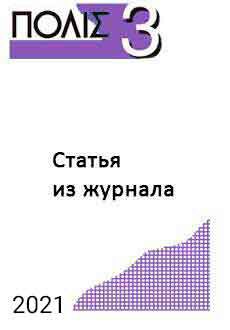Online shop of "Polis. Political Studies" Journal
We in the world, the world in us
Akhremenko A.S., Belenkov V.E., Petrov A.P. The Logic of Protest Campaigns: From Empirical Data to Dynamic Models (and Back). – Polis. Political Studies. 2021. No. 3. P. 147-165. (In Russ.)
150 руб.
The most important political protests are long-lasting campaigns where a large number of various interrelated events and actions – both for protesters and for the authorities – intersect. At the same time, empirical research tools – statistical methods and data sets – are more suitable for the study of one-off events, not related to each other in time. In this article, on the broad basis of existing research, the authors demonstrate two characteristic features of this approach – the phenomenon of “over-aggregation” and the problem of “independent events”. In the first case, all parameters of protest episodes are averaged over the campaign as a whole, or over years or months. In the second case, researchers tend to form a sample of such episodes on the assumption that they are not related to each other. Both of these perspectives lead to the internal dynamics of protest campaigns being ignored, failing to take into account a number of their important features. Among such features are the nature of information asymmetry between protesters and authorities, decision-making based on information about the previous protest events (their size on the first place), the systemic effects of “cascades” and “tipping points” in the development of the protest movement, and the effects of learning. We propose agent-based mathematical model to solve these methodological problems and to depict these dynamics. In the model we present the set of potential protesters as a social network; individuals make decisions about participation in “today’s” protest event on the basis of previous events. This approach considers a protest campaign as a chain of events, and enables empirically testable hypotheses to be formulated inferred not only from theory but also from the results of model experiment.
The most important political protests are long-lasting campaigns where a large number of various interrelated events and actions – both for protesters and for the authorities – intersect. At the same time, empirical research tools – statistical methods and data sets – are more suitable for the study of one-off events, not related to each other in time. In this article, on the broad basis of existing research, the authors demonstrate two characteristic features of this approach – the phenomenon of “over-aggregation” and the problem of “independent events”. In the first case, all parameters of protest episodes are averaged over the campaign as a whole, or over years or months. In the second case, researchers tend to form a sample of such episodes on the assumption that they are not related to each other. Both of these perspectives lead to the internal dynamics of protest campaigns being ignored, failing to take into account a number of their important features. Among such features are the nature of information asymmetry between protesters and authorities, decision-making based on information about the previous protest events (their size on the first place), the systemic effects of “cascades” and “tipping points” in the development of the protest movement, and the effects of learning. We propose agent-based mathematical model to solve these methodological problems and to depict these dynamics. In the model we present the set of potential protesters as a social network; individuals make decisions about participation in “today’s” protest event on the basis of previous events. This approach considers a protest campaign as a chain of events, and enables empirically testable hypotheses to be formulated inferred not only from theory but also from the results of model experiment.
 English
English Русский
Русский

Reviews
There are no reviews yet.